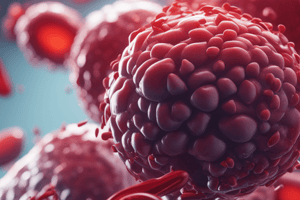Podcast
Questions and Answers
What activates factor X in the coagulation process?
What activates factor X in the coagulation process?
- Factor VII only
- Factor VII and intrinsic pathway factors together
- Both extrinsic and intrinsic pathways separately (correct)
- Factor III and factor VII (correct)
Which factor initiates the extrinsic coagulation pathway?
Which factor initiates the extrinsic coagulation pathway?
- Factor II
- Factor III (tissue factor) (correct)
- Factor VII
- Factor X
Which pathway is involved in the activation of factor X?
Which pathway is involved in the activation of factor X?
- Only the extrinsic pathway
- Only the intrinsic pathway
- Both extrinsic and intrinsic pathways (correct)
- None of the above pathways
What is the role of factor III in coagulation?
What is the role of factor III in coagulation?
In which pathway does factor VII play a critical role?
In which pathway does factor VII play a critical role?
Which factors are involved in the intrinsic pathway of coagulation?
Which factors are involved in the intrinsic pathway of coagulation?
Which factors are part of the common pathway in the coagulation process?
Which factors are part of the common pathway in the coagulation process?
How many factors are utilized in the intrinsic pathway?
How many factors are utilized in the intrinsic pathway?
Which of the following combinations represents factors from both the intrinsic and common pathways?
Which of the following combinations represents factors from both the intrinsic and common pathways?
Which factor is NOT part of the common pathway?
Which factor is NOT part of the common pathway?
Flashcards
Extrinsic Pathway
Extrinsic Pathway
The process of blood clotting that begins when a blood vessel is damaged and tissue factor (TF) is exposed.
Tissue Factor (TF)
Tissue Factor (TF)
A protein found on the surface of cells that initiates the extrinsic coagulation pathway when exposed to blood.
Factor III
Factor III
A compound made from the liver (not in blood normally) that, when exposed to tissue factor, activates Factor VII
Factor VII
Factor VII
Signup and view all the flashcards
Common Pathway
Common Pathway
Signup and view all the flashcards
What are the factors involved in the intrinsic pathway?
What are the factors involved in the intrinsic pathway?
Signup and view all the flashcards
What are the factors involved in the common pathway?
What are the factors involved in the common pathway?
Signup and view all the flashcards
What is the role of Factor XII?
What is the role of Factor XII?
Signup and view all the flashcards
What is the role of Factor X?
What is the role of Factor X?
Signup and view all the flashcards
What is the role of Factor II?
What is the role of Factor II?
Signup and view all the flashcards
Study Notes
Anticoagulation and Thrombosis
- Coagulation is a complex process where blood forms clots.
- It's crucial for hemostasis, which stops blood loss from damaged vessels.
- Coagulation disorders can cause excessive bleeding or clotting (thrombosis).
Hemostasis Mechanisms
- Hemostasis is maintained through three mechanisms:
- Vascular spasm: Damaged blood vessels constrict.
- Platelet plug formation: Platelets adhere to damaged endothelium to form a plug (primary hemostasis).
- Blood coagulation: Clots form (secondary hemostasis) from fibrinogen to fibrin.
Coagulation Pathways
- Coagulation involves three pathways:
- Extrinsic pathway: Initiated by tissue factor (factor III) and interacts with factor VII.
- Intrinsic pathway: Involves factors XII, XI, IX, and VIII.
- Common pathway: Uses factors X, V, II, I, and XIII to form a stable clot.
- Extrinsic and intrinsic pathways both lead to the common pathway.
Triggers of Pathways
- Extrinsic pathway is triggered by the release of biochemicals from damaged blood vessels/tissue.
- Intrinsic pathway is triggered when blood contacts damaged endothelial lining of blood vessel walls (no tissue damage).
Coagulation Goal
- The main goal of coagulation is to form a stable blood clot to stop bleeding and allow tissue repair.
- Coagulation disorders impact the coagulation cascade, leading to either excessive or insufficient clotting.
- Common disorders include deficiencies in clotting factors (like hemophilia) and vitamin K deficiency.
Prothrombin Time (PT/INR) Test
- Measures how quickly blood clots.
- Abnormal results (high PT/INR) indicate slower-than-normal clotting.
- Possible causes include bleeding/clotting disorders, liver problems, or vitamin K deficiency.
- If on warfarin, it's a sign of blood thinning disorder or liver issues.
- Vitamin K is crucial for blood clotting to prevent excessive bleeding.
Anticoagulants
- Anticoagulants prevent or delay blood clotting.
- Common anticoagulants include heparin and warfarin.
- These drugs, are also known as blood thinners, reduce clot formation.
Studying That Suits You
Use AI to generate personalized quizzes and flashcards to suit your learning preferences.



